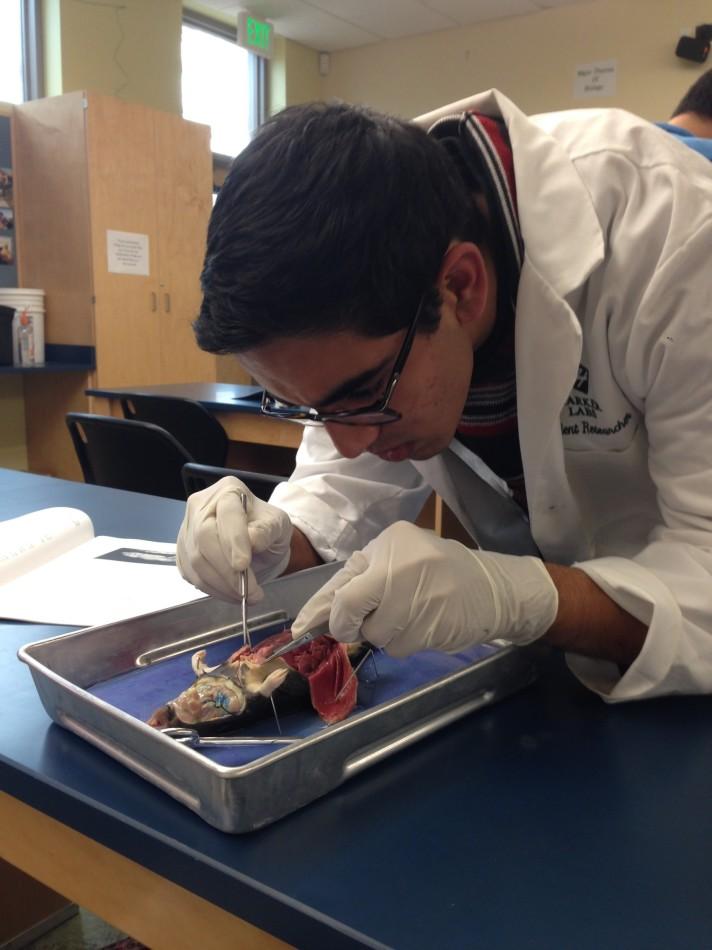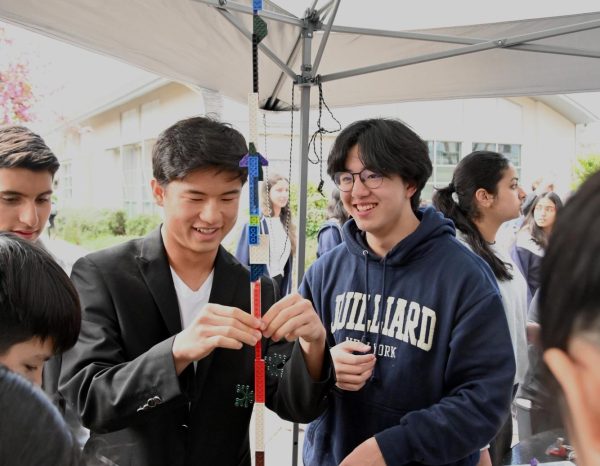Biology students participate in rat dissection
Jai Ahuja (11) cuts the skin off of a rat to observe it’s digestive tract. Students also identified organs such as the heart, stomach, small intestine, and kidney.
The juniors in Mike Pistacchi’s honors biology classes dissected rats today in order to build upon their knowledge of anatomy and physiology.
During the dissection, students worked in duos or trios to identify the different organ systems that they had learned about, such as the circulatory system and the digestive system.
“I think dissections are a great way to get into the animal you’re working with and really get a sense of how biology works in the real world,” Nikhil Reddy (11) said.
Pistacchi hoped that the exercise would allow students to further understand the biological structures and functions in a body through a hands-on lab rather than in a visual activity.
“It’s a chance to see all of the organ systems that we’ve been looking at pictures of in person and see what they really look like,” he said. “It gives the students a real view of what organs look like and how they’re all attached to each other.”
Students had previously dissected pigs’ hearts and frogs, but the experiment with the rats gave students a more thorough and comprehensive perspective in which they could link the different body systems together.
“I liked today’s dissection with the rat the most because after learning about the different systems for the past few months, I finally got to observe how everything is connected,” Sachin Peddada (11) said. “My group also used its knowledge from the pig’s heart dissection to study the rat’s heart as well.”
Although there are no more dissections planned for the rest of the year, the students will be able to observe the cerebral structures of the brain during a demonstration taking place on their next long block period.
Angeline Pan is the assistant Photo Editor of TALON. She is a junior and has been part of the journalism program since her sophomore year. Her favorite...































![Setter Emma Lee (9) sets the ball to the middle during the match against Pinewood on Sept. 12. “[I’m looking forward to] getting more skilled, learning more about my position and also becoming better friends with all of my teammates, Emma said.](https://harkeraquila.com/wp-content/uploads/2023/09/DSC_4917-2-1200x795.jpg)















































































![“[Building nerf blasters] became this outlet of creativity for me that hasnt been matched by anything else. The process [of] making a build complete to your desire is such a painstakingly difficult process, but Ive had to learn from [the skills needed from] soldering to proper painting. Theres so many different options for everything, if you think about it, it exists. The best part is [that] if it doesnt exist, you can build it yourself, Ishaan Parate said.](https://harkeraquila.com/wp-content/uploads/2022/08/DSC_8149-900x604.jpg)


![“Animation just clicked in a way. I had been interested in art, but that felt different. [Animation] felt like it had something behind it, whereas previous things felt surface level. I wasnt making that crazy of things, but just the process of doing it was much more enjoyable, Carter Chadwick (22) said.](https://harkeraquila.com/wp-content/uploads/2022/08/Screen-Shot-2022-08-16-at-9.44.08-AM-900x598.png)


![“When I came into high school, I was ready to be a follower. But DECA was a game changer for me. It helped me overcome my fear of public speaking, and its played such a major role in who Ive become today. To be able to successfully lead a chapter of 150 students, an officer team and be one of the upperclassmen I once really admired is something Im [really] proud of,” Anvitha Tummala (21) said.](https://harkeraquila.com/wp-content/uploads/2021/07/Screen-Shot-2021-07-25-at-9.50.05-AM-900x594.png)



![“[Volleyball has] taught me how to fall correctly, and another thing it taught is that you don’t have to be the best at something to be good at it. If you just hit the ball in a smart way, then it still scores points and you’re good at it. You could be a background player and still make a much bigger impact on the team than you would think,” Anya Gert (’20) said.](https://harkeraquila.com/wp-content/uploads/2020/06/AnnaGert_JinTuan_HoHPhotoEdited-600x900.jpeg)

![“Im not nearly there yet, but [my confidence has] definitely been getting better since I was pretty shy and timid coming into Harker my freshman year. I know that theres a lot of people that are really confident in what they do, and I really admire them. Everyones so driven and that has really pushed me to kind of try to find my own place in high school and be more confident,” Alyssa Huang (’20) said.](https://harkeraquila.com/wp-content/uploads/2020/06/AlyssaHuang_EmilyChen_HoHPhoto-900x749.jpeg)













![“My slogan is ‘slow feet, don’t eat, and I’m hungry.’ You need to run fast to get where you are–you arent going to get those championships if you arent fast,” Angel Cervantes (12) said. “I want to do well in school on my tests and in track and win championships for my team. I live by that, [and] I can do that anywhere: in the classroom or on the field.”](https://harkeraquila.com/wp-content/uploads/2018/06/DSC5146-900x601.jpg)

![“I think getting up in the morning and having a sense of purpose [is exciting]. I think without a certain amount of drive, life is kind of obsolete and mundane, and I think having that every single day is what makes each day unique and kind of makes life exciting,” Neymika Jain (12) said.](https://harkeraquila.com/wp-content/uploads/2017/06/Screen-Shot-2017-06-03-at-4.54.16-PM.png)



















